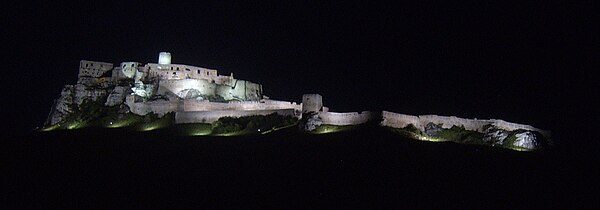This is an old revision of this page, as edited by 194.160.75.10 (talk) at 13:25, 26 June 2008 (It doesn't belong here according to Misplaced Pages's guidelines). The present address (URL) is a permanent link to this revision, which may differ significantly from the current revision.
Revision as of 13:25, 26 June 2008 by 194.160.75.10 (talk) (It doesn't belong here according to Misplaced Pages's guidelines)(diff) ← Previous revision | Latest revision (diff) | Newer revision → (diff)The ruins of Spiš Castle (Slovak: Audio file "Spissky hrad.ogg" not found) in eastern Slovakia form one of the largest castle sites in Central Europe. The castle is situated above the town of Spišské Podhradie and the village of Žehra, in the region known as Spiš (Szepes). It was included in the UNESCO list of World Heritage Sites in 1993 (together with the adjacent locations of Spišská Kapitula, Spišské Podhradie and Žehra).
History
Spiš Castle was built in the 12th century on the site of an earlier castle. It was the political, administrative, economic and cultural centre of Szepes county. Before 1464, it was owned by Hungarian kings, afterwards (until 1528) by the Szapolyai family, the Thurzo family (1531-1635), the Csáky family (1638-1945), аnd (since 1945) by the State.

Originally a Romanesque stone castle with fortifications, a two-story Romanesque palace and a three nave Romanesque-Gothic basilica were constructed in the area by the second half of the 13th century. A second extramural settlement was built in the 14th century, by which the castle area was doubled. The castle was completely rebuilt in the 15th century; the castle walls were heightened and a third extramural settlement was constructed. A late Gothic chapel was added around 1470. The Szapolyai clan performed late Gothic transformations, which made the upper castle into a comfortable family residence, typical of late Renaissance residences of the 16th and 17th centuries. The last owners of the Spiš Castle the family Csáky deserted the castle, in early 18th century considered too uncomfortable to live in. They moved to the newly build nearby village castles/palaces in Hodkovce by Žehra (Zsigra) and Spišský Hrhov (Görgő). In 1780, the castle burned down and has been in ruins since. The castle was partly reconstructed in the second half of the 20th century, and extensive archaeological research was carried out on the site. The reconstructed sections house displays of the Spiš Museum.
Present day
In 2006, the castle attracted about 170,000 visitors. The castle is also frequently used as a location for films, including Dragonheart (1996), Phoenix, Kull the Conqueror (1997), The Lion in Winter (2003), The Last Legion (2006).

Pictures
-

-

-

-

-

-
 The keep at the centre of the castle.
The keep at the centre of the castle.
-

-

-

-

-

-

References
External links
- Official website of Spiš Castle Template:Sk icon
- Tourist information about Spiš Castle and nearby Dreveník
- History of Spiš Castle
- Panoramic photos of Spiš Castle